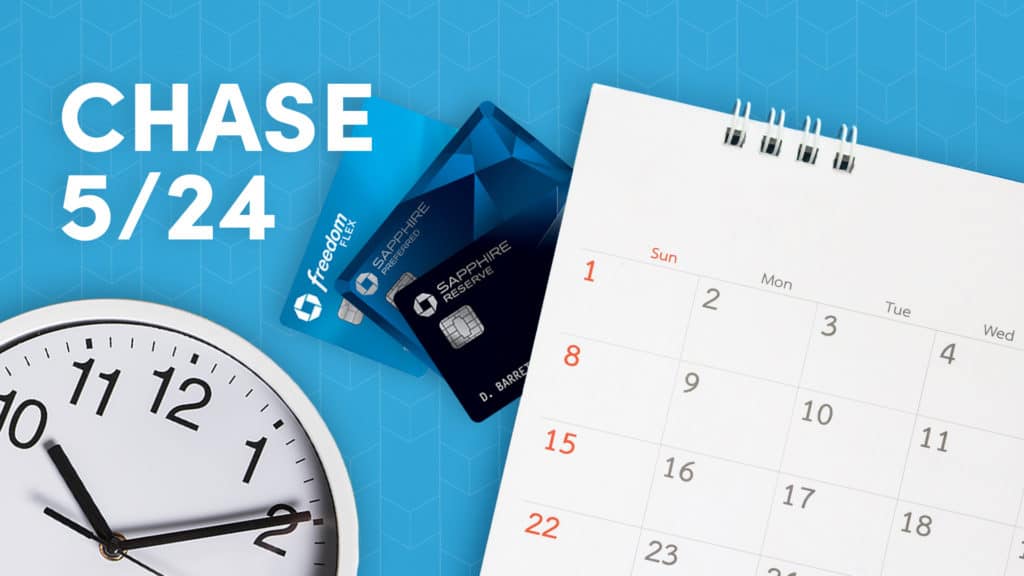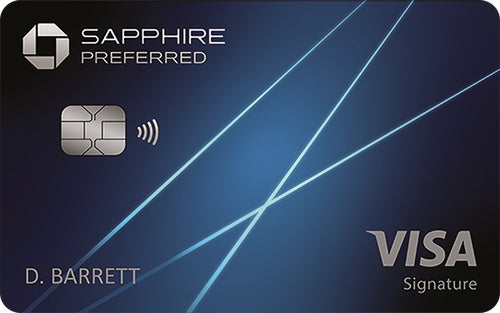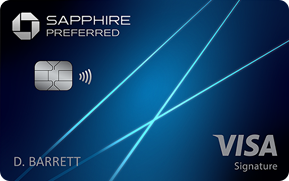MileValue is part of an affiliate sales network and receives compensation for sending traffic to partner sites, such as CreditCards.com. This compensation may impact how and where links appear on this site. This site does not include all financial companies or all available financial offers. Terms apply to American Express benefits and offers. Enrollment may be required for select American Express benefits and offers. Visit americanexpress.com to learn more.
Note: Some of the offers mentioned below may have changed or are no longer be available. You can view current offers here.
There are a few fundamental rules to the success of anyone involved in points and miles. If there’s one that is more important than any other, it is the Chase 5/24 rule.
The Chase 5/24 rule is so fundamental that you’ll almost always hear someone mention it when discussing sign up strategies. “What’s your 5/24 status?” is almost always the first question asked when someone asks for credit card recommendations.
If you haven’t heard of the 5/24 rule yet, you may be wondering what the big deal is. Stay with me as we dive into the Chase 5/24 rule and how it impacts almost every decision you’ll make in points and miles.

What Is The Chase 5/24 Rule?
The Chase 5/24 rule isn’t any rule written in stone. You won’t find it come up on any Chase credit card application or in any banker rulebook. The Chase 5/24 rule has been around long enough for us to know that it exists, even if it isn’t memorialized in fine print.
Put simply, the Chase 5/24 rule states you will be automatically denied for a Chase credit card if you’ve opened 5 or more personal credit cards from any bank in the past 24 months.
It is important to note that these credit cards are from any bank. You will be denied if you opened 5 Home Depot credit cards or 5 Citi credit cards. Any combination of 5 credit cards, both within and outside of Chase, opened in the past 24 months will result in an automatic denial by Chase of an application for a new Chase card.
You’ll often hear people refer to the number of cards they’ve opened in the past 24 months as X/24. For example, if I said I’m 13/24, that means I’ve opened 13 cards in the past 24 months. Just a little terminology to familiarize yourself with as you get more involved in points and miles.
This rule may seem a bit unfair, but there’s actually some sound reasoning to having the rule.
Why Would Chase Have A 5/24 Rule?
Banks don’t exist to lose money. The Chase 5/24 rule is in place to prevent people from opening too many cards too rapidly just for the bonuses. If you aren’t opening cards with too high a velocity, you’ll never exceed the 5/24 rule and Chase is happy to extend credit to you. However, for customers opening more than 5 cards every 24 months, there’s a good chance they’re either doing it just for the sign-up bonus or they may be at a high risk of defaulting on credit.
The rule wasn’t implemented to punish anyone, but merely to protect the banks interest.

Chase Sapphire Preferred® Card
Earn 60,000 bonus points after you spend $4,000 on purchases in the first 3 months from account opening.
What Cards Count Towards The Chase 5/24 Rule?
On the surface, it may seem that any card counts towards the Chase 5/24 rule, but it isn’t so simple.
For starters, any personal credit card that you open counts towards your 5/24 status.
In addition to personal credit cards, any cards that you’re an authorized user on count against your 5/24 status. This is why we don’t recommend adding your spouse or having them add you on any accounts unless it is absolutely necessary.
If this does apply to you, you can make a reconsideration call and have Chase manually review the account. If this doesn’t succeed, you can remove yourself as an authorized user, then call and ask the bank to remove it from your credit profile. After this, call Chase again or apply again. Although reapplying isn’t the best for your credit score, you may be outside the window for reconsideration once the authorized user account falls off your credit report.
Keep in mind, even a closed account will count towards your Chase 5/24 status. Chase can still see when the account was opened and count it against you.
Despite what it seems, not all cards count towards your 5/24 status.
What Cards Don’t Count Towards Your 5/24 Status
There are limited options for cards that don’t count towards 5/24, but thankfully they do exist.
To put it briefly, any card that doesn’t report to your personal credit report won’t count towards your 5/24 status. When you apply for a new Chase card, Chase pulls your personal credit report. If a card isn’t on there, Chase can’t see it and count it against you.
When you’re looking for cards that don’t count towards your 5/24 status, your best bet is business cards. Not all business cards are created the same, however. Some actually do report to your personal credit report, so they will count against you.
The following banks do not report business credit cards to your personal credit report, so any business cards with these banks will not affect your Chase 5/24 status:
- American Express
- Bank of America
- Barclays
- Chase
- Citi
- US Bank
- Wells Fargo
The following banks do report their business credit cards to your personal credit report, so any business cards with these banks will impact your Chase 5/24 status:
- Capital One
- Discover
Although there may be some other smaller local or regional banks out there, your mileage will vary with them. You’ll have to do some independent research or try calling the bank and asking before signing up for a card with them.
Pay special attention to the fact that Chase business cards do not report to your personal credit report. This means that Chase business credit cards will not count towards your 5/24 status. Although it is a bit counterintuitive, there’s enough data to suggest this is a sound rule and a safe one to go by when planning your credit card strategy.
The Best Way to Check Your 5/24 Status
For starters, you should be getting a copy of your annual credit reports at least once a year to review. Your full credit reports can be a bit dense, but it is good to review for any errors that may be negatively impacting your credit.
When you’re opening multiple cards a year, your credit report will vary. Checking it just once a year simply isn’t enough to know what your 5/24 status is at any time.
The best way to stay on top of your 5/24 status is by using a free credit service such as Credit Karma. While the credit score you’ll see on Credit Karma isn’t the most accurate, the score is calculated from information from your credit report.
Credit Karma organizes this information from your credit report in a way that makes it easy to determine your 5/24 status.
On the home page, Credit Karma will show your credit scores. Click on one to be taken to your credit factors. Once there, click on credit card usage. You’ll be shown a list of your cards and how much credit is used on each one. You can expand the card to see when the card was opened.
Keep in mind, your account won’t necessarily be in chronological order from when you opened them, but instead are in chronological order based on when the card was last reported to the credit bureau.
Be sure to check both your TransUnion and Equifax. Not all card issuers report to every credit bureau, so checking both and going with your highest number will be your safest option when determining your Chase 5/24 status.
I’d highly recommend putting this information in a spreadsheet that you update every time you open a new card. That way, you’re actively keeping track of your 5/24 status as you go along in this hobby.
What Cards are Impacted by The Chase 5/24 Rule?
Previously, there were some Chase cards you could get if you were over 5/24. Unfortunately, that changed a few years ago. Chase decided to tighten up and the rule now applies for every available Chase card.
Although they won’t count towards your 5/24 status, this does apply to Chase business cards as well. So if you’re over 5/24 and apply for a business card, you will still be denied for a Chase business card as well as any personal cards.
Why Should You Care About the Chase 5/24 Rule?
There are a lot of reasons you should care about the Chase 5/24 rule. Once you get going in points and miles, it is easy to open more than 5 cards in 24 months. Some people open 10, 15, or more.
Once you’ve opened more than 5 cards in 24 months, you won’t be able to get any Chase cards. There are some very valuable Chase cards, such as the Chase Sapphire Preferred® Card.
Chase has some exclusive travel partners that you won’t be able to earn bonuses for from any other bank. Partners like Hyatt, which has some of the lowest award redemption rates out of any major hotel brand out there. Or partners like Southwest.
If you’re over 5/24 you won’t be able to earn the Southwest Companion Pass. I can speak to how valuable the Companion Pass is because I’m writing this article on a Southwest Flight with my wife who was able to fly for no additional points thanks to our Companion Pass.
Meanwhile, you’ll still be able to open cards from banks like American Express or Citi once you are over 5/24. The rule only applies to Chase. Why open a card from American Express when you can still get the bonus later? When it comes to Chase, you’ll be cut off as soon as you start opening too many cards. Cut off from valuable opportunities that you would otherwise miss out on.
How to Lower Your Chase 5/24 Status
If you want to open some Chase cards but you’ve opened more than 5 cards in the past 24 months, you’ll need to lower your 5/24 status. The only way to do this is to wait and slow down on opening cards.
This doesn’t mean you can’t open any cards at all, but you’ll want to limit your credit card applications to business cards with card issuers that don’t report to your personal credit report. That way you’re able to still get bonuses while waiting to be below 5/24.
Other than waiting, there’s no other way to lower your 5/24 status. No matter how much you beg or plead, Chase simply isn’t going to let you open a new card if you’re above 5/24.
Final Thoughts
If you’re new to points and miles, the Chase 5/24 rule is so important I implore you to read this a few times before opening your first card. The Chase 5/24 rule is restrictive, but not so restrictive that it will stop you from opening any Chase cards. You just need to know how to approach it and have a strategy with your card applications.
For advice on that strategy, feel free to reach out to us for a free credit card consultation. We will help plan out the right credit card strategy for you that takes the Chase 5/24 rule into consideration.
Just getting started in the world of points and miles? The Chase Sapphire Preferred is the best card for you to start with.
With a bonus of 60,000 points after $4,000 spend in the first 3 months, 5x points on travel booked through the Chase Travel Portal and 3x points on restaurants, streaming services, and online groceries (excluding Target, Walmart, and wholesale clubs), this card truly cannot be beat for getting started!
Editorial Disclaimer: The editorial content is not provided or commissioned by the credit card issuers. Opinions expressed here are the author’s alone, not those of the credit card issuers, and have not been reviewed, approved or otherwise endorsed by the credit card issuers.
The comments section below is not provided or commissioned by the bank advertiser. Responses have not been reviewed, approved, or otherwise endorsed by the bank advertiser. It is not the bank advertiser’s responsibility to ensure all questions are answered.


